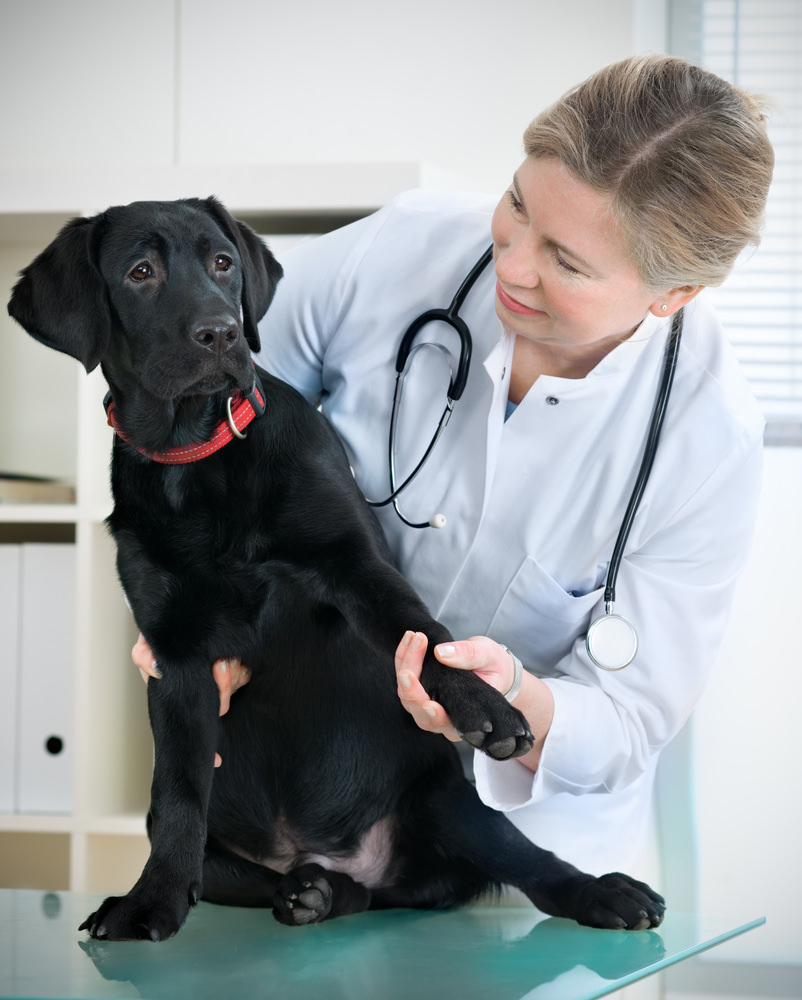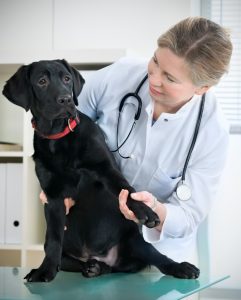Elbow Dysplasia in Dogs

Free Pet Insurance Comparison
Compare Quotes From Top Companies and Save
Secured with SHA-256 Encryption
Dr. Pippa Elliott BVMS, MRCVS
Veterinarian
Dr Pippa Elliott BVMS, MRCVS is a veterinarian with over 30 years of experience in companion animal practice. In 1987 she graduated from the University of Glasgow, with a degree in veterinary medicine and surgery. She works at Blythwood Vets and the People’s Dispensary for Sick Animals (PDSA). Pippa is an advocate of Fear-Free Practice, an animal addict, and a veterinary writer. She is also w...
Veterinarian
UPDATED: Feb 3, 2025
Pet Insurance U receives compensation from the third parties included on this site. This includes payment for clicks from our site to insurance providers’ sites and quote requests generated. Our rankings and reviews are not affected by payments from the insurance companies. The compensation we receive allows the site to be free and regularly updated. Our goal is to review every pet insurance provider, but not all companies are listed on the site.
And many of the companies we review do not pay us anything. We simply rate, compare and review their plan because we feel it will be valuable to you. Our reviews are guaranteed to be unbiased, professional and advertising compensation does not influence rankings.
We are a free online resource for anyone interested in learning more about pet insurance. Our goal is to be an objective, third-party resource for everything pet insurance related. We update our site regularly, and all content is reviewed by pet insurance experts.
UPDATED: Feb 3, 2025
Pet Insurance U receives compensation from the third parties included on this site. This includes payment for clicks from our site to insurance providers’ sites and quote requests generated. Our rankings and reviews are not affected by payments from the insurance companies. The compensation we receive allows the site to be free and regularly updated. Our goal is to review every pet insurance provider, but not all companies are listed on the site.
And many of the companies we review do not pay us anything. We simply rate, compare and review their plan because we feel it will be valuable to you. Our reviews are guaranteed to be unbiased, professional and advertising compensation does not influence rankings.
On This Page
Elbow dysplasia in dogs is one of the most common causes of elbow lameness and pain in larger dogs.
It is usually caused by a genetic growth abnormality in a dog’s tissue, bones, and cells.
As the abnormalities in the elbow become more acute over time, it can lead to the deterioration of a dog’s elbow joints.
It is very similar to the symptoms and outcome of arthritis, yet it occurs in the elbow joint.
There are also a number of elbow-specific diseases that are considered as different forms of elbow dysplasia.
Elbow dysplasia is usually seen in puppies who grow too quickly. A diagnosis can be made within the first 18 months of a dog’s life.
Table of Contents:
Need Pet Insurance?
FACT: Pet insurance pays up to 90% of vet bills when your pet is sick or injured!
Elbow Dysplasia Symptoms
Some of the symptoms of elbow dysplasia could be displayed at four months old, while some dogs might not have any symptoms until later in life.
Both elbows are usually affected, although one may show more severe symptoms than the other.

Some of the most common signs of elbow dysplasia:
- Limping
- Pain and lameness in forelimbs
- Thickening of the elbow
- Development of arthritis, or inflammation of the joint
- Advanced joint disease
- Painful to extend the elbow
- Raising hurt limb outward as in a slow kick
- Stiffness
- Difficulty in getting up after sleeping
- Fluid in the elbow joint
Enter your ZIP code below to view companies that have cheap pet insurance rates.
Secured with SHA-256 Encryption
Breeds Affected by Elbow Dysplasia
Medium sized and larger breeds that are most commonly affected by Elbow Dysplasia.
Some common breeds that suffer from Elbow Dysplasia are the following:
- Labrador Retrievers
- Labradoodles
- Golden Retrievers
- Chow Chows
- Collies
- German Shepherds
- Bernese Mountain Dogs
- Newfoundlands
Related: 10 Things You Must Know Before You Buy Pet Insurance
Causes of Elbow Dysplasia
There are a few factors that can lead to elbow dysplasia issues:
Genetics
Some joint deformities that are present at birth (congenital) can cause elbow dysplasia when the joints haven’t properly grown.
This can be due to a breed-specific condition or just an abnormality.
Nutrition
Dogs who are overweight or have not been fed properly will develop elbow and joint issues because of the excess weight.
Real Cost Savings from PetFirst Clients

Luna
PetFirst saved his parents
$6,712
A happy energetic Luna one morning couldn’t hold her food down. After months of multiple costly vet visits to specialists and an endoscopy, the problem was discovered and fixed. Luna put 22 pounds back on in no time and her parents were grateful for having PetFirst by their side to pay the bills.
Diagnosis
Your vet will run a variety of tests to determine if there are other conditions other than elbow dysplasia such as an infection, arthritis or an injury to the joint.
X-rays are likely to be taken to rule out tumors or any other growth. They can further determine if there are any joint breaks or fragment around the elbow.
An MRI or another imaging test, a CT scan, can also help diagnose the same more precisely. (For more information, read our “Does pet insurance cover CT scans?“).
Your vet will also want to run some blood tests, a urinalysis, and even an arthroscopic exam.
It’s important to get treatment for your dog’s elbow dysplasia as soon as you see the signs as there are other afflictions that can occur as a result of the disease such as canine osteoarthritis.
Osteoarthritis can cause constant pain and swelling.
Enter your ZIP code below to view companies that have cheap pet insurance rates.
Secured with SHA-256 Encryption
Elbow Dysplasia Treatment Options
Treatment depends on the exact form and stage of the disease. Pain and anti-inflammatory medications are options when surgery is not feasible, as is physical therapy.
Below are some of the different treatment options available:
Lifestyle Change
If your dog is young and already has signs of elbow dysplasia, a change in lifestyle will be necessary.
Weight management will be imperative to keep the dog lean and a change of exercise. Walking instead of running, swimming or low impact exercise.
Weight Control
It is very important to keep the weight down of dogs’ with elbow dysplasia. The less weight your dog has, the less stress he will put on his or her joints.
Your vet can give you some specific recommendations of the right diet for your pup and it might even be a weight-control prescription formula.
Surgery
Some dogs are good candidates for surgery.
The surgery is intended to take out the broken or loose pieces of the joint or cartilage in the hurt elbow.
After surgery, it’s equally important to do the follow-up physical therapy necessary to aid your dog’s elbow joint in healing.
Your veterinarian will give you recommendations of different range-of-motion exercises to perform on your dog.
Activity will be restricted after surgery, but it’s vital to exercise your dog’s limbs to stop atrophy in that elbow and even the other limbs from occurring.
Rehabilitation Therapy
There are many different forms of alternative and rehab therapies that can help dogs with elbow dysplasia such as:
- Massage
- Hydrotherapy
- Swim Therapy
- Acupuncture
- Joint Mobilization
Does Pet Insurance Cover Elbow Dysplasia?
Elbow dysplasia is covered by many pet insurance companies, as long as your dog has coverage before he shows any signs of the condition when it is then considered pre-existing.
Since elbow dysplasia usually affects both sides of the body, policies would have to cover bilateral conditions to cover treatment of both forelimbs.
With the cost of surgery and even rehab costing anywhere from $5,000 to $15,000, pet insurance can save you up to 90% of the cost.
Plans like Healthy Paws can help with not only the cost of surgery but the rehab that is required to help your dog heal with alternative therapy being covered in all their plans.
If you have a breed that is pre-disposed to this condition, make sure that you enroll your dog in a pet insurance plan before your pup exhibits symptoms and the condition is then called pre-existing.
Prevention
Because elbow dysplasia is a genetic trait, it is generally recommended that dogs who exhibit symptoms of elbow dysplasia not be breed.
And then spaying and neutering would be advised for the specific dog.
Weight management is also helpful in reducing the risk of elbow dysplasia and, really, any other condition in a dog.
A proper, well-balanced diet will also aid in weight control and appropriate nutrition.
Enter your ZIP code below to view companies that have cheap pet insurance rates.
Secured with SHA-256 Encryption
Management
If your dog has elbow dysplasia or any type of elbow issue, it’s important to keep up with your annual vet exams to determine the condition of your dog’s elbow.
Your veterinarian will usually conduct follow-up X-rays and blood work to make sure the elbow and the other joints are functioning properly.
If you continue to see your vet, keep your pup’s weight in control, and keep your dog active, but overly so, your dog can continue to enjoy life without pain.
If you are interested in learning more about other diseases or conditions that could afflict your dog, our dog glossary is a great resource of information.
Other articles you may find helpful:
Is Exotic Pet Insurance Necessary?
The Best Pet Insurance By State
Fun Facts, Dog FAQ, And Unsolicited Dog Advice
5 Training Commands to Save Your Dog’s Life
The Ultimate Guide to Safe Foods for Dogs
We get it, your dog is like your child and when your puppy or dog has health problems it is scary. Luckily there is pet insurance companies that will help you pay for any veterinarian care they made need. Checkout the best puppy and dog pet insurance companies and learn about common puppy health issues and ailments in older pets.
Common Health Problems:
Chronic Active Hepatitis in Dogs
Cruciate Ligament Tear in Dogs
Degenerative Myelopathy | Spinal Cord Disease In Dogs
Dementia in Dogs | Canine Cognitive Dysfunction
Dog Comedones (Schnauzer Bumps)
Dog Diarrhea: What Can You Do To Help?
Gallbladder Obstruction in Dogs
Heart Murmurs In Dogs | How To Identify Them
Intervertebral Disc Disease In Dogs
Nasal Solar Dermatitis In Dogs
Progressive Retinal Atrophy In Dogs
The Dog Flu – Symptoms & Treatment for Canine Influenza

Frequently Asked Questions
Is the website secured with encryption for privacy?
Yes, the website is secured with SHA-256 Encryption, ensuring the privacy and security of your information.
Who is the author of the content on Elbow Dysplasia in Dogs?
The content on Elbow Dysplasia in Dogs is written by Melanie Musson, a published insurance expert.
Can you tell me about the background of the insurance expert, Melanie Musson?
Melanie Musson is the fourth generation in her family to work in the insurance industry. She has an in-depth knowledge of state-specific car insurance laws and dynamics, as well as a broad understanding of how insurance fits into every person’s life.
Who reviewed the content on Elbow Dysplasia in Dogs?
The content was reviewed by Dr. Pippa Elliott BVMS, MRCVS, a veterinarian with over 30 years of experience in companion animal practice.
What is the publication date of the content on Elbow Dysplasia in Dogs?
The content was last updated on November 17, 2020.
Does the website receive compensation for promoting insurance providers?
Yes, Pet Insurance U receives compensation from third parties included on the site, which includes payment for clicks and quote requests. However, rankings and reviews are not influenced by payments.
Is the website a reliable resource for pet insurance information?
Yes, the website aims to be an objective, third-party resource for pet insurance-related information. Reviews are guaranteed to be unbiased, professional, and advertising compensation does not influence rankings.
What is Elbow Dysplasia in Dogs?
Elbow Dysplasia in Dogs is one of the most common causes of elbow lameness and pain in larger dogs. It is usually caused by a genetic growth abnormality in a dog’s tissue, bones, and cells.
What are the symptoms of Elbow Dysplasia in Dogs?
Symptoms of Elbow Dysplasia could be displayed as early as four months old, and common signs include lameness, pain, and deterioration of the elbow joints.
Which dog breeds are commonly affected by Elbow Dysplasia?
Medium-sized and larger breeds are most commonly affected by Elbow Dysplasia. Some common breeds include Labrador Retrievers, German Shepherds, and Golden Retrievers.
What are the causes of Elbow Dysplasia in Dogs?
Elbow Dysplasia can be caused by genetic factors, joint deformities present at birth, and issues related to nutrition, especially in dogs who are overweight or improperly fed.
How is Elbow Dysplasia diagnosed in dogs?
Diagnosis involves various tests, including X-rays, blood tests, urinalysis, and potentially an MRI or CT scan to determine the extent of the condition.
What are the treatment options for Elbow Dysplasia in Dogs?
Treatment options include lifestyle changes, weight control, surgery to remove broken or loose joint pieces, and rehabilitation therapy.
Does pet insurance cover Elbow Dysplasia?
Many pet insurance companies cover Elbow Dysplasia, as long as the dog is enrolled before showing any signs of the condition. Pet insurance can save up to 90% of the treatment cost.
Can Elbow Dysplasia be prevented in dogs?
Since Elbow Dysplasia is a genetic trait, it is generally recommended that dogs exhibiting symptoms not be bred. Weight management and a proper diet also contribute to prevention.
What is the role of management in dealing with Elbow Dysplasia in dogs?
Regular vet exams, weight control, and keeping the dog active without excessive strain are essential for managing Elbow Dysplasia and preventing further complications.
Is there a directory of articles and guides on the website for more pet-related information?
Yes, the website offers a directory of articles and guides on various pet-related topics, providing additional information beyond Elbow Dysplasia.
Enter your ZIP code below to view companies that have cheap pet insurance rates.
Secured with SHA-256 Encryption
Dr. Pippa Elliott BVMS, MRCVS
Veterinarian
Dr Pippa Elliott BVMS, MRCVS is a veterinarian with over 30 years of experience in companion animal practice. In 1987 she graduated from the University of Glasgow, with a degree in veterinary medicine and surgery. She works at Blythwood Vets and the People’s Dispensary for Sick Animals (PDSA). Pippa is an advocate of Fear-Free Practice, an animal addict, and a veterinary writer. She is also w...
Veterinarian
We are a free online resource for anyone interested in learning more about pet insurance. Our goal is to be an objective, third-party resource for everything pet insurance related. We update our site regularly, and all content is reviewed by pet insurance experts.
